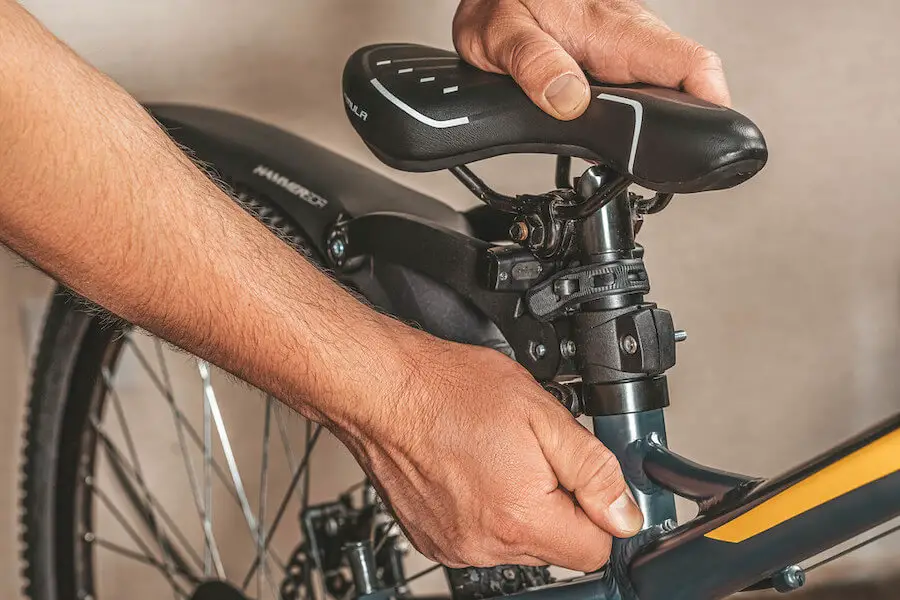Mountain bikes are primarily built for riding off-road. They include tactical characteristics aimed to enhance toughness and performance on rugged terrain.
The firm seats of these bikes are a common source of complaint. Why are mountain bike seats so hard? Many reasons are causing this discomfort.
Let’s delve into this article to learn more!
Table of Contents
Why Are Mountain Bike Seats So Hard?
Mountain bikes have hard seats to help firmly support the rider’s muscles while minimizing the risk of osteoarthritis.
To prevent soft tissue injury, you need to know that the pedal should have the flexibility of movements and cushioning only when necessary.
A firm seat to guard your vulnerable regions may sound paradoxical, but it is the reality.
Even though they can initially feel painful, how do these things help you be more effective?
Here are in-depth explanations for the discomfort of a mountain bike’s seat:
Give Your Sit Bones The Support They Need.
It is a good idea to consider the requirements and the connections with the bicycle when cycling a road bike.
Legs may move freely while riding the bike thanks to the support provided by the butt, seat, and torso.
Let’s analyze the contact point between the saddle and your butt. This connection’s purpose is to bear most of your body weight.
Your legs used for pedaling support partially your weight. Nevertheless, the legs don’t use torso weight when pedaling downhill but the leg weight.
For this reason, most torso weight often transfers via your butt and puts stress on the bike’s seat.
Your thighs should be sufficiently loose from the seat so that your legs may move in a spectrum that corresponds with pedaling.
Your butt will only touch a smaller area than if you sit on a couch.
The seat must be relatively firm to sustain the pressure in a small space since the contact surface is so little.
Avoid Damaging The Soft Tissue.
The ischial tuberosities must bear the weight of your torso while you are riding a bicycle.
A part of the weight may pass through the soft tissue if the weight presses a soft cushion to one side, into the perineum.
That’s why the seat should be harder to prevent your soft tissue from injuries while riding.
Boost The Effectiveness Of Pedaling.
Your torso weight moves in both directions when you cycle. The seat and your butt at that point must allow for the side movement and the pedaling motion.
When you press down on the pedal and shift some of the weight to help with the downstroke, it’s a complicated physics activity.
Therefore, you must have a solid seat that you can partially lean on when you shift your body mass to the pedals.
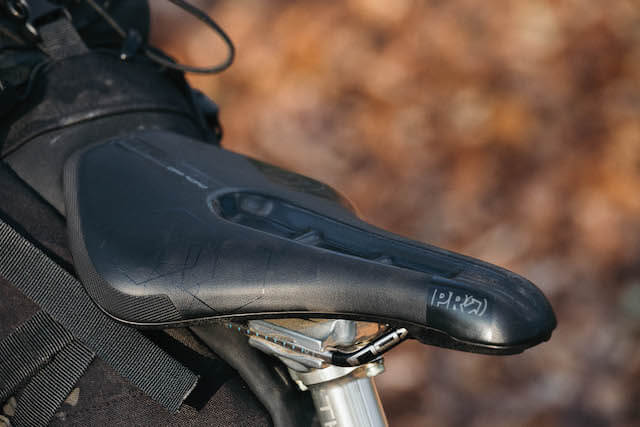
How To Sit On A Hard Mountain Bike Seat Properly?
Due to improper seating, riders frequently find smaller seats exceedingly unpleasant.
Below is how to position yourself correctly, like professional riders, on various seats.
- Try to put pressure on the legs to preserve the ischial tuberosities and keep your hands loose.
- The ideal knee posture is bending midway between being upright and contacting your saddle.
- You can absorb shocks and control bumps considerably better in this position than sitting.
- Make sure your spine and tailbone are in alignment. This posture promotes blood flow while protecting your tension points.
- You must adjust the posture of your hips to engage your glutes by bending the body forward and pressing the hips back.
- Keep your shoulders low while riding your bike on challenging terrain.
- After adjusting your shoulders, make sure your elbows are out and parallel to them.
- It is easy to activate the biceps, back muscles, and if the elbows are out.
- If these muscles are wholly engaged, you’ll have less trouble pulling, pushing, and tilting the bike.
- It would be best to lead with the chin while climbing short slopes while riding.
- It would help if you stared in the intended direction while holding your head up.
- Your weight shifts forward as you drop your head, which puts more strain on your back.
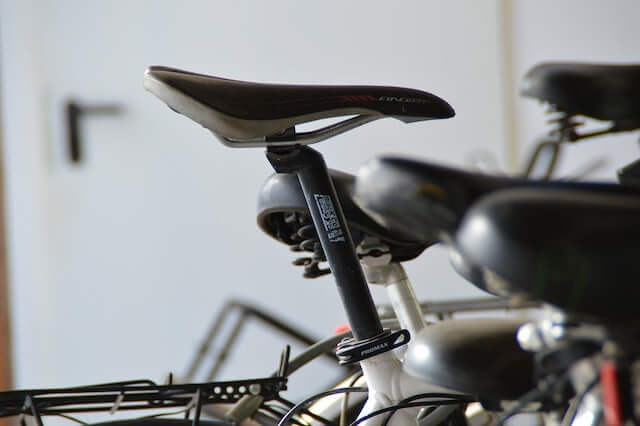
How To Reduce Saddle Soreness On A Mountain Bike?
You may find riding on the mountain bike’s saddle uncomfortable for the first time. You can prevent this soreness with the following tips. Let’s keep reading!
1. Make Handlebar Adjustments
The too low or too high handlebars may result in back, butt, and neck discomfort.
Incorrect weight distribution on the hands from high handlebars puts a more significant strain on the butt.
Your handlebars must be either slightly higher than the saddle or as tall as it to enable you to sit erect.
Many riders may endure back pain, decreased performance, and saddle sores if it’s too low for handlebars.
2. Stand Up
Your whole body weight rests on your butt while you are sitting. When you’re nearing hills, try to stand up.
You must sit on the seat for around two hours or more if you ride 22 miles.
Poor circulation, less breathability, and damp crotch regions lead your butt to become numb and painful.
While cycling, standing up might help you gain more muscles and ride better.
3. Select The Proper Seat
Using the improper seat might cause discomfort since males’ and females’ pelvises differ.
Choosing the incorrect seat might result in restricted blood circulation to the perineum or discomfort in squeezed nerves.
Thus, choose the appropriate saddle if you plan to buy a mountain bike.
4. Buy Thin Padding
Avoid seat coverings with plenty of cushioning since they tend to put extra strain on the ischial tuberosities and become worthless.
Instead, choose one with less cushioning, strengthening your saddle and making riding more comfortable.
5. Make A Weight Change
It would help if you did not put your entire weight on a bicycle saddle. It will be uncomfortable to put your whole weight on the bike seat.
Your handlebars, hands, seat, crotch, feet, and pedals should all bear equal amounts of the weight of your body.
The goal is to distribute your weight such that the handlebars bear 30 percent and 70 percent of your torso weight, respectively.
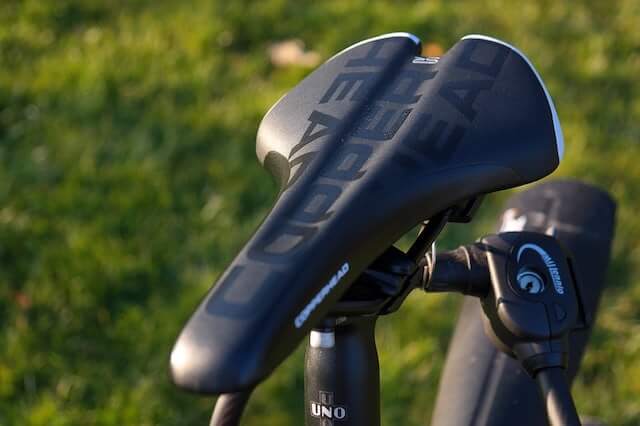
6. Wear The Suitable Shorts
Novice beginners often underestimate biking shorts. Instead, they tend to invest in decent earphones for their journeys.
However, padded shorts seem to be essential while biking at any time.
If your tailbone is delicate, you should wear appropriate shorts with lots of cushioning to avoid pain.
7. Completely Occupy The Seat
Because every person’s butt is unique, there are no fixed sizes. You will need a bicycle saddle that is wide enough for your butt.
Your tailbone bears most of your torso weight rather than the soft tissues.
Saddle pain results from an uneven weight distribution in a small saddle. It will rub against your crotch if it is extensive.
8. Test The Tires
Most riders forget to check the tires’ pressure before starting a journey. You will have to pedal more forcefully if your bike’s tires are consistently low pressure.
It hurts worse while you’re on the seat because of the road’s imperfections.
Since your rear tire will carry most of your body weight, the usual bike pressure must be between 22 and 35 psi.
9. Lose Weight
Compared to heavier riders, slimmer persons frequently experience minor butt soreness.
You’re suffering pain since these extra weights are straining the saddle. Thus, losing weight is an excellent solution to consider for cyclists.
10. Replace The Seat
If you’ve tried the above solutions but feel pain, it’s time to get a new seat. Go to the local bike store to choose the ideal saddle size.
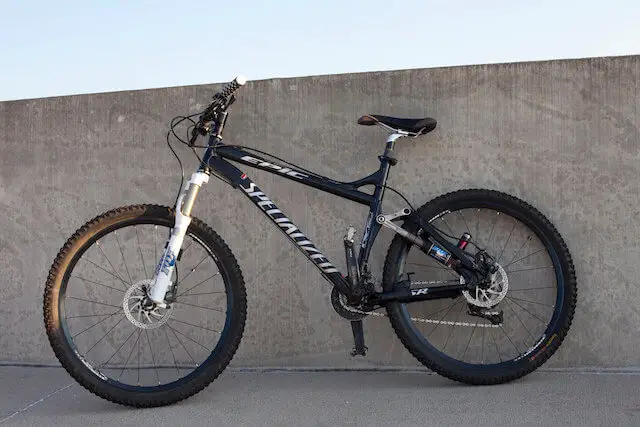
FAQs
Why Are Mountain Bike Seats Small?
The bike seat should be small for easier paddling. You will feel your thighs rubbing against the saddle’s sides if it is broader or larger.
Why Are Mountain Bike Seats High?
The seats of mountain bikes are high to improve the force and effectiveness of the pedals.
It enables virtually complete leg extension when pedaling, reducing knee damage risk. Your bike will handle better since the gravity will be higher.
How Long Does It Take To Get Used To A Mountain Bike Seat?
The average riding required to become accustomed to a brand-new bicycle seat is between 0 and 250 miles.
If you ride about 30 miles or more each week, it can take 0 – 8 weeks to become accustomed to a saddle.
Several variables, including the materials, design, and fit of your particular seat, will affect the time this procedure will take.
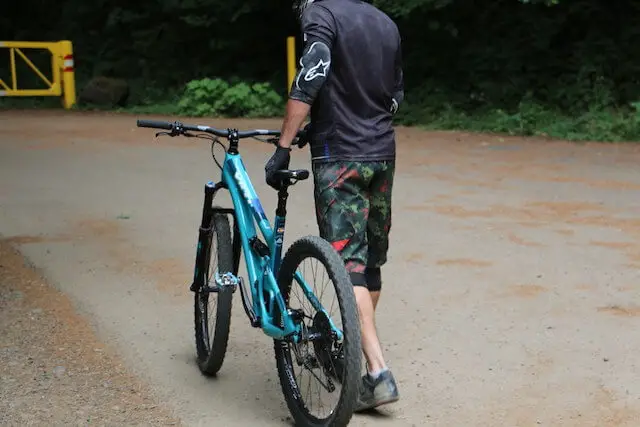
The Bottom Line
Why are mountain bike seats so hard? They must be firm to support the riders’ soft tissue and ischial tuberosities, which improves pedaling efficiency.
Hopefully, you can relieve saddle soreness while riding with our helpful tips. If you have further questions, please leave a comment below.
Thanks for reading this post!

